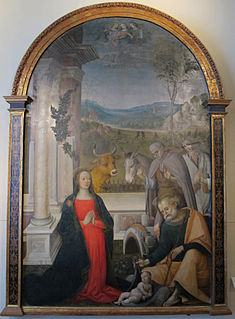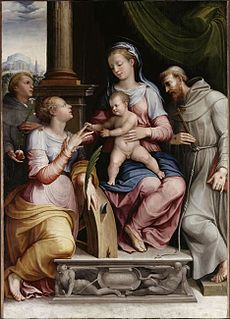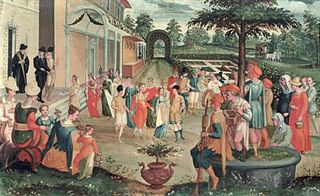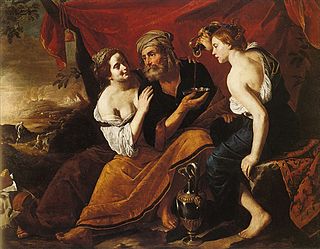
Duccio di Buoninsegna was an Italian painter active in Siena, Tuscany, in the late 13th and early 14th century. He was hired throughout his life to complete many important works in government and religious buildings around Italy. Duccio is credited with creating the painting styles of Trecento and the Sienese school, and also contributed significantly to the Sienese Gothic style.

The Ecole de Fontainebleau (c.1530–c.1610) refers to two periods of artistic production in France during the late Renaissance centered on the royal Palace of Fontainebleau that were crucial in forming the French version of Northern Mannerism.

Giacomo Pacchiarotti or Jacopo Pacchiarotto was an Italian painter.

Giottino, also known as Tommaso Fiorentino, was an early Italian painter from Florence. His real name was Maso di Stefano or Tommaso di Stefano.

Giovanni Battista di Jacopo, known as Rosso Fiorentino, or Il Rosso, was an Italian Mannerist painter, in oil and fresco, belonging to the Florentine school.

Cristofano or Cristoforo Gherardi, also known as il Doceno, was an Italian painter of the late-Renaissance or Mannerist period, active mainly in Florence and Tuscany.

Giuseppe Nicola Nasini was an Italian painter of the Baroque period, active in Rome and Tuscany.

The Madonna of the Magnificat, Italian: Madonna del Magnificat, is a painting of circular or tondo form by the Italian Renaissance painter Sandro Botticelli. It is now in the galleries of the Uffizi, in Florence.

Orazio Alfani was an Italian painter of the Renaissance period, active in both Palermo and Perugia.

Cristoforo Rustici, known as il Rusticone, was an Italian painter active in Siena who is known for his religious compositions and allegorical scenes representing the twelve months.

Dello di Niccolò Delli, also known as Dello Delli, Dello di Niccolò and Dello, was an Italian sculptor and painter from Florence. His father was a tailor named Niccolò di Dello. Painters Nicola Delli and Sansone Delli were his less famous younger brothers.

Hendrick de Somer, often erroneously referred to as Hendrick van Someren or Hendrick van Somer, known in Italy as Enrico Fiammingo and Henrico il Fiamingo was a Flemish painter who spent most of his life and career in Italy where he was mainly active in Naples. He was known for his religious and mythological compositions and occasional genre painting. His style was initially influenced by the Spanish painter Jusepe de Ribera who worked in Naples and was a follower of Caravaggio. Later the painter became influenced by the neo-Venetian and Bolognese schools. He is considered one of the leading Netherlandish painters working in Naples in the first half of the 17th century.
The year 1521 in art involved some significant events and new works.

Stefano Fiorentino (1301–1350) was an Italian painter of the time of Giotto.

Vincenzo Rustici was an Italian painter active in Siena. He was known for his religious compositions as well as his vedute showing public celebrations in Siena.
Francesco d'Antonio or d'Antonio di Bartolomeo was an Italian painter of the Renaissance, mainly active in Florence. He is likely the same Francesco Fiorentino that Giorgio Vasari in his biographies states was a follower of Lorenzo Monaco. In 1429 Francesco joined the painters' guild in Florence. A triptych signed attributed to Francesco is found in the Fitzwilliam Museum, Cambridge. A painted depiction of the Virgin and Child with Six Angels and Two Cherubim on a gilded background found at the National Gallery, London.

An anonymous author known as the Anonimo Gaddiano, Anonimo Magliabechiano, or Anonimo Fiorentino is the author of the Codice Magliabechiano or Magliabechiano, a manuscript with 128 pages of text, probably from the 1530s and 1540s, and now in the Central National Library of Florence. It includes brief biographies and notes on the works of Italian artists, mainly those active in Florence during the Middle Ages. Among several other suggestions, the anonymous author has been suggested to be Bernardo Vecchietti (1514–1590), a politician of the court of Cosimo I. The author clearly had intimate access to the Medici court.
Giovanni di Lorenzo Larciani was an Italian painter. He was originally referred to as the Maestro dei paesaggi Kress.

















